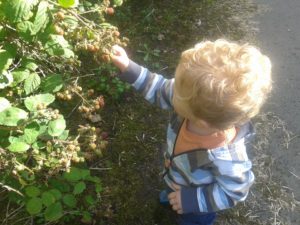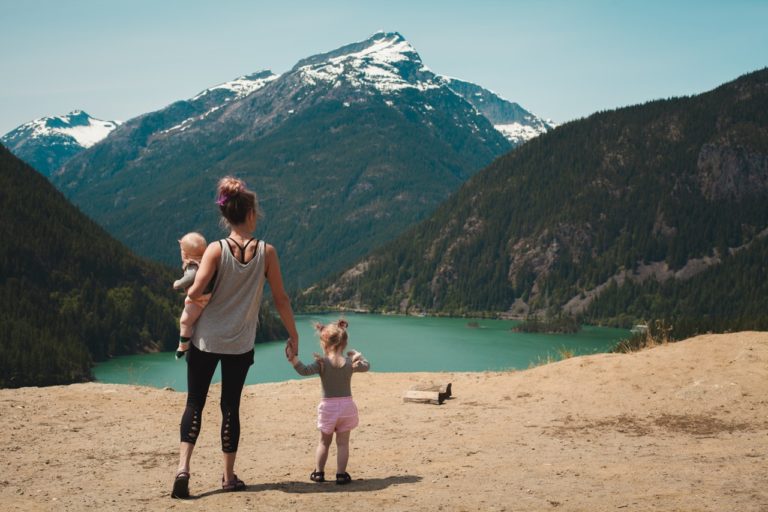Supporting Your Toddler’s Risky Play
Last spring I went for a hike in the Lake District. Towards the end of the hike I stopped to take a few photos and watch some ducks on a river that ran near the trail. As I lingered, I heard a mother call out to her son, ‘Be careful!’. I turned to look and saw a small boy, maybe four years old, at the top of a steep, grassy hill. I watched as he started to come down. Even from a distance I could see how thoughtfully he took each step. He wisely cut diagonally across the slope as he came down. Whether he knew that this made his descent less steep, or if it just ‘felt’ right, I don’t know, but he didn’t falter and proudly made it to the bottom of the hill.

In the meantime, the mother continued to call out, telling her child to be cautious and slow, despite his focus and attention. I imagine she had visions of him tumbling head over heels down the hill. I can totally relate to that. My kids, especially toddler N, have both given me near heart attacks from ending up in precarious places, usually at playgrounds. However, it is becoming more and more clear that the best way to keep our children from harm is to allow them to take risks.
I’m not saying that we should let our children play with fire and knives while our backs our turned. But as parents, we need to recognize the role that risk-taking plays in our child’s development and then support it.
What is risk?
Risk and risky play can bring a lot of images to mind. I tend to think of my toddler slipping on wet, tall playground equipment. Maybe you think of your child burning herself or tripping and falling. Because we all have different ideas of what risk is, I think it is important to define risk and then look at the difference between risk and danger.
- A risk is a situation where a child is exposed to a known hazard when that child understands the nature and consequences of that hazard.
- A danger is a situation where a child is exposed to a hazard where he is unaware of the hazard, its nature, or the consequences of that hazard.
A risk is a calculated decision where the child evaluates whether or not he wants to make an attempt at something that could bring about harm or failure. A lack of awareness or evaluation probably mean that the child is in danger.
Think about a child around a campfire. In order for the situation to be a risk, the child would have to know that the fire has been lit (he knows the hazard), that fire can move and spread (the hazard’s nature), and that it causes burns (the consequences of the hazard). If the child isn’t aware of any of these things, then the situation is actually dangerous.
I find the distinction between risk and danger really helpful in day-to-day life. I do my best to keep my kids from danger. I do let my children enter situations where they are aware of the hazard, how it works, and its consequences.

Why support risky play?
Knowing the difference between danger and risk is all well and good, but a child around fire could still burn himself. A child climbing a tree could still fall. So why take a chance? Why should we let our kids get into risky situations?
This is where the research really gets compelling. The book Child-Initiated Play and Learning provides a great summary, and picks up highlights including:
- Risky play promotes concentration and immersion in play;
- Risky play requires children to use all of their senses, physical skills and mental power;
- Risky play helps children’s neural structures to grow;
- Risky play encourages an intrinsic desire to learn because uncertainty triggers the motivation and reward portion of the brain;
- Risky play develops resilience and tenacity in children as they encounter challenges, fail, try again, and succeed;
- Risky play allows children to progress and develop physically, cognitively, and emotionally, therefore helping them reach their potential.
The author says several times that children are hardwired for risky play. Avoiding it, preventing it, or prohibiting it can stunt a child’s development. We all want our children to grow into independent, resilient adults. Risky play is a key component of developing those traits.
How do you support risky play?
Maybe on the spectrum of parenting, you lean slightly towards ‘helicopter’. Perhaps you are the mom who spends most of the time at the playground reminding your child to be careful, to slow down, to climb down from that tree. I hope that it’s clear that I am not advocating laissez-faire parenting, turning the other direction and praying your child doesn’t get hurt. I think that there are really helpful, practical steps we can take to support our children in their risky play. I especially think that with care and the right perspective, we can raise kids who will actually be safer, more self-aware, and more confident as they face any number of challenges in life. Here are some suggestions.
- Trust your child. Your child knows much more about her abilities and how the situation feels than you do. Kids tend to moderate their risk-taking in line with what they are comfortable with and what they know they are capable of (Brussoni 2012). This means we don’t need to remind our children to be careful: they already are. I also think this means that we need to allow our children to choose what situations they get themselves into. Carl and I have made the choice to not help our children climb playground equipment (or anything, really). Instead of placing them on top, we wait for them to decide to climb up themselves. This lets them take on the risk of height when they are ready.
- Create (or go to) the right environment. Playground equipment that is build from a ‘safety first’ perspective is probably going to be easily conquered by your child. Because of this, we need to take the initiative in getting our children to places that provide a variety of challenges. Woodland, beaches, and other natural spaces provide uneven, varied surfaces to navigate, rocks or trees to climb. Your own backyard may provide a spot for a campfire or space to run fast. Even in your home, consider introducing your child to tools, such as hammers and knives. Be aware of other factors, like having younger siblings around, that mean your attention is divided and you aren’t able to give your child the focused attention they need when trying something new.
- Discuss risks (but don’t take them away). As you can see from above, awareness is a key part of mitigating risk. As your toddler becomes more verbal, and even before, talk about risks. Be matter of fact, rather than patronizing or fearful. ‘The fire is hot. It could burn,’ instead of, ‘Be careful, the fire is soooo hot. It will give you a big owie!’ We don’t want to scare our children! Ask questions like, ‘What would happen if you slipped?’ to gauge his understanding of the situation. At that point, then, let the child test his ability: climb the ladder, run down the hill, roast a marshmallow over an open fire.
- Affirm smart behavior. I mostly try to keep quiet while my child is doing something risky. My fear is that even saying ‘be careful’ will distract my child, potentially causing him to get hurt. Instead, I do my best to watch, and keep calm by observing his focus and ingenuity. When N has accomplished something, I like to give feedback that is positive and specific. ‘I like how you tested each rung before you took a step’. ‘I saw how you came down those steps backward.’ ‘Thank you for walking slowly when you are near the fire’. Again, I aim for a casual tone, just like when I am discussing a risk.
Risk-taking is such an important part of growing up. Our little ones need opportunities to test themselves, to fail, to try again. These situations will help them learn to navigate situations in all parts of life with awareness and confidence, and these qualities lead to make wise decisions that minimize the chance of our coming to harm.
How do you respond when you see your child doing something risky?






Thanks for the great post! I am a big fan of allowing risk taking…and have become much better at it with my second child! Somehow you learn to trust they’ll be ok. And I think they grow so much stronger as a result! Great, sound reasons and benefits, I love how you included research, and your affirmations sound like great examples of descriptive praise.
I think it is easier with the second – a bit more going on, plus the benefit of having seen that the oldest has made it just fine! Really glad you enjoyed the post, Rachel!